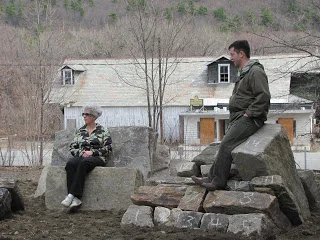Yesterday, Professor Markku Hakuri took me for a train and bus ride to check out the site for my installation at the Kerava Art Museum. This morning I went ten miles outside of Helsinki to a look at gravel pit. A ‘tailings’ pile I found there has the right ingredients for making a piece that combines twelve hollow cones into a mound shape. Because a group of university art students will be helping me, it’s important that the stones be easily shifted and lifted by hand, and the cones and mound be definable with lines and guide frames. This afternoon I made a 3-D sketch in clay of the design I’ve been working on in my head for the past couple of days.
Read MoreTo be an effective dry stone waller one needs to be an efficient materials manager. An abundance of stone must be gathered, transported, shifted and lifted before a wall comes to completion. Handling stone more than necessary wastes time, and more importantly, personal energy.
The lessons I’ve learned in managing stone have been valuable in other areas of life.
Read MoreThe lead up to most of my projects can take months of correspondence and cogitation. That’s alright with me because it allows time for my dreams and desires to grow and wither, or grow and flourish, as they will, before the first stone is picked up and put down. Now and then, an offer to do a project will pop up and within a matter of days things start to happen. Such was the case with this construction, begun yesterday and completed today. The stones, Monkton quartzite and Panton limestone, were leftovers from masonry work previously done on the home. The site was the back yard with a wide view of the Champlain Valley. The customer’s wish was to have a place to sit for stargazing.
Read MoreIf you went looking for a bunch of guys building stone walls you probably wouldn’t start under an old barn, but that’s where you would have found them today in Dummerston, Vermont. The former milking parlor at Scott Farm has been transformed into a top-notch training and testing site. Eight wallers from as far north as Minnesota and as far south as North Carolina were taking their Level 1 and 2, Dry Stone Walling Association of Great Britain, certification tests.
Read MoreWork on the 8th hole stone fence at Cochecho Country Club in Dover, New Hampshire ended on a bright note yesterday with sunny skies. The golfers were out in droves. It will be interesting to see how the new wall becomes part of course play. A ball that hits the wall will ricochet toward the green instead of bounding, as it would have previously, into the rough. In any case, Brian and I are happy to be out of the line of fire from long drives gone astray.
Read MoreIt’s not every school where you can see chickens free-ranging on the lacrosse field during a practice, but Green Mountain College isn’t every school. During a recent visit to Poultney, Vermont to lecture and instruct a walling workshop at the college I discovered a vibrant educational community that’s leading the way in environmental studies. The eight students I worked with were a ready and willing group. They quickly grasped the concepts and principles of dry stone wall construction and jumped right into building. By the end of the afternoon they had laid up a 24 foot long section of retaining wall using slate cut-offs from a local quarry/fabricator.
Read MoreAfter the snow has gone and before the leaves bud out there’s a pause between seasons that’s just right for exploring the woods. Because the forest floor litter has yet to rebound from its recent compaction from the weight of snow, land shapes are clearly defined. Ancient trees have left evidence of their former stature in the earth pillows and cradles created by their toppling and uprooting. Dark, moist ledge outcrops and loose stone screes stand out on dry slopes. Stone fences, once lining high meadows, now stand only as a testament to a bygone sheep farmer’s singular tenacity.
Read MoreAn inch of rain isn’t the best way to start a new job, but that’s what I got Wednesday in Dover, New Hampshire where I was beginning construction at a golf course. The original fence ran alongside of an old town road. Its remnants had been pulled down by the course maintenance crew and a new footing established away from the tree line. By Thursday afternoon the clouds lifted and the wind began to dry the mud. Friday was beautifully sunny.
Read MoreThree days this week were devoted to dismantling and reassembling a sculpture titled ‘Rock Rest’. The piece was designed and constructed last December at my stone yard with the intention that it would eventually be installed at the Brattleboro Museum and Art Center’s new sculpture garden. On Sunday I numbered and catalogued the 50+ stones in the piece and transported them, by five truck and trailer loads, seven miles to Brattleboro. The stones were spread out across the parking lot in preparation for placement in the piece.
Read MoreCultivated land is a handmade environment. Over the past two centuries, the rural face of Vermont has been shaped by farm life. While the stone walls built during that time have lost their stature as livestock fences, their presence has become a defining characteristic of the land. A dry laid stone wall, that has stood the test of time, is praised for its practicality, durability and craftsmanship. The close attention farmers pay to their surroundings is comparable to the awareness artists bring to their work. As a medium of expression, dry stone construction is a logical choice for an artist working in the landscape.
Read More








